North Korea Conducts Large Rocket Motor Tests: Construction at Sohae Launch Pad
Summary
Despite its failed rocket test last spring, commercial satellite imagery indicates that North Korea continues to develop long-range missiles, possibly with intercontinental ranges. Since the failed launch, the North has conducted at least two, and possibly more, tests of large rocket motors at its Sohae Satellite Launching Station, the most recent in mid-September 2012. These tests, critical for the development of new rockets, appear to have been of liquid-fueled, first stage engines for either the Unha-3 satellite launch vehicle or the new KN-08 long-range missile first viewed in a parade in Pyongyang last April.
In addition, commercial satellite imagery of the Sohae rocket launch area indicates construction activity on the upper gantry platform required for future launches of long-range rockets much larger than either the Unha-3 or the KN-08. 38 North previously reported indications, from open media and from construction activity at its launch facilities, that the North is developing such a rocket.
In the aftermath of the US and South Korean presidential elections, Pyongyang may embark on a new round of activities in the first half of 2013, including rocket and nuclear tests that will contribute to further development of its nuclear deterrent. Whether the testing of large rocket motors or construction at the launch pad are in preparation for such activities remains unclear at this point.
DPRK Test Stands
North Korea has three known liquid-fueled rocket test stands. The first and smallest was built in the early 1980s at a missile production facility outside Pyongyang and appears intended to test engines for the SCUD and Nodong missiles. That facility has not been used since the early 2000s. A second large stand was built at the Tonghae Satelite Launching Ground (commonly referred to as Musudan-ri) probably in the early 1990s and has been used to test the cluster of four Nodong engines in the Unha first stage. While still operational, it does not appear to have been used recently. The third and largest engine test facility was built at the new Sohae Satellite Launching Station (commonly referred to as Tongchang-ri) and became operational with it first engine test in June 2008. The stand is capable of testing the Unha’s first stage as well as clusters of engines for the much larger rocket reportedly seen at a Pyongyang missile research and development facility in April 2012.
Summer 2012 Rocket Engine Tests
Pyongyang appears to have conducted at least one and possibly more large rocket engine tests at Sohae between April 13 and September 17 this year. Imagery from April 9 shows 34 fuel tanks positioned on each side of the fuel propellant storage building at the test stand (see figure 1).
Figure 1. Activity at the rocket engine test stand in early April 2012.
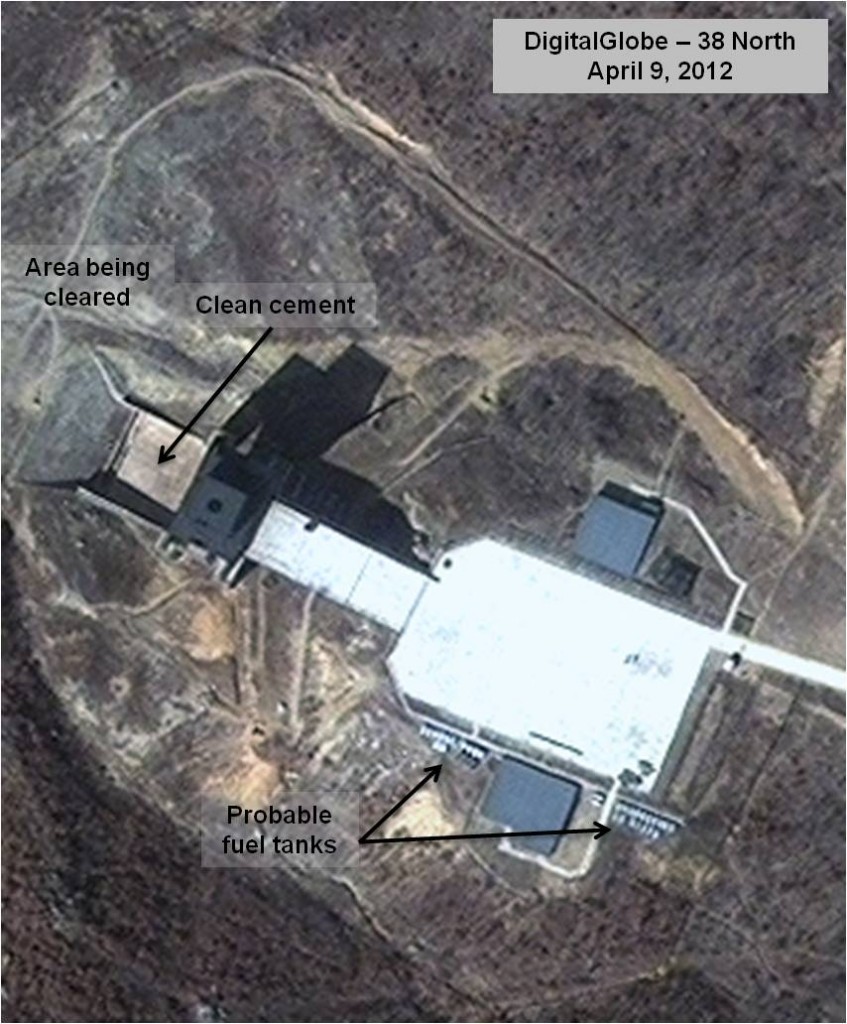
The next available imagery from September 17 shows several changes that indicate that rocket motor tests have been conducted, including: 1) the fuel tanks are no longer present; 2) the flame trench is stained orange, indicating engine tests have occurred (this is the residue in the exhaust from burning the propellants); and 3) the vegetation past the east side of the trench appears to have been burned (see figure 2).
Figure 2. Probable engine testing prior to September 17, 2012.
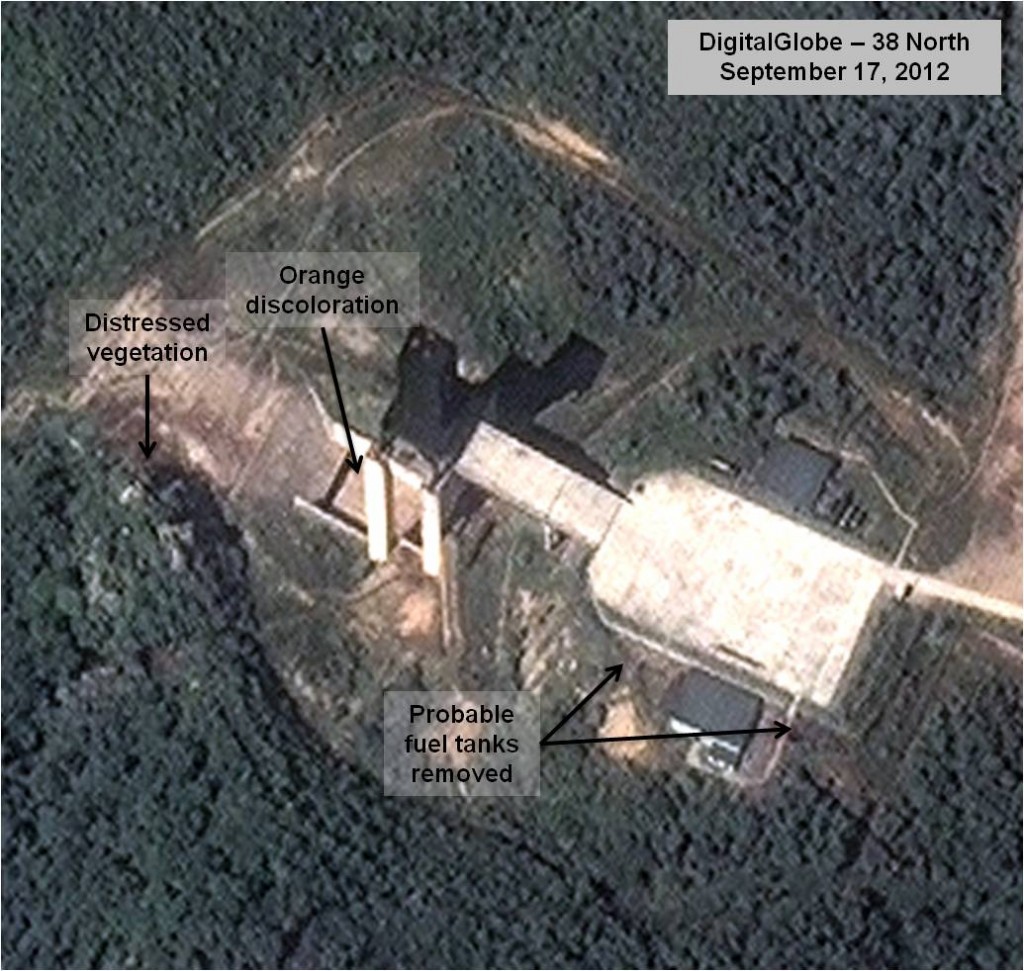
The fuel stored at the facility may provide an important clue as to which engines were tested. Existing fuel and oxidizer storage buildings at the site may have contained propellant for the first stage of the Unha rocket. Moreover, tests of the first stage may have been necessary given several reports suggesting that problems with it caused the failed flight test last April. Whether enough time elapsed between the April failure and the rocket motor tests conducted over the summer, in order to allow the North Koreans to analyze flight data on what went wrong, is unclear.
Pyongyang may have also conducted tests of the KN-08 long-range missile. The 34 additional tanks, about 1.2 meters in diameter and 2.2 meters in length, appear to be the standard 500 liter Soviet propellant tank previously seen in the DPRK, which has been used to store high-energy propellants more powerful than those used for the Unha first stage. Such propellant, used in the second and third stages of that rocket, is also believed to be the fuel for the three stage KN-08 missile still under development, first seen on display in an April 2012 parade in Pyongyang. If this is the case, then the tests conducted during the summer may have also included the first stage of the KN-08 rocket.
Late September 2012 Rocket Engine Test
Imagery from September 28 indicates that another rocket engine test has recently been conducted (see figure 3). Once again, the flame trench is discolored and additional vegetation directly in front and on the left side of the trench appears to have been burned. Also, a small crane and truck were now spotted on the pad in addition to a number of probable propellant tanks. The crane was likely used to load and unload the rocket engine at the test stand. Finally, about a third of the way up the road from the test stand to the instrumentation site, there are recent vehicle tracks seen in the pull-offs (see figure 4). Optical instrumentation was first observed at this location supporting an engine test in June 2008.
Figure 3. Activity at the rocket engine test stand on September 28, 2012.
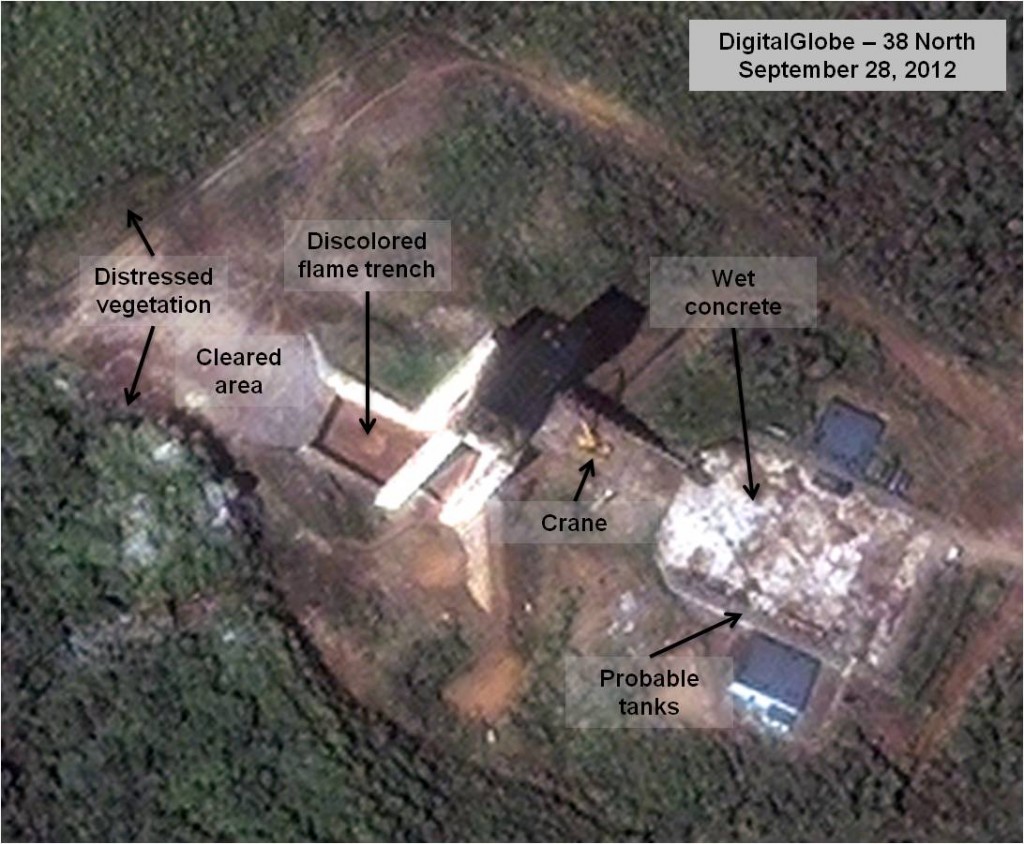
Figure 4. Comparison of April and September 2012 photos of optical instrumentation positions supporting engine testing.
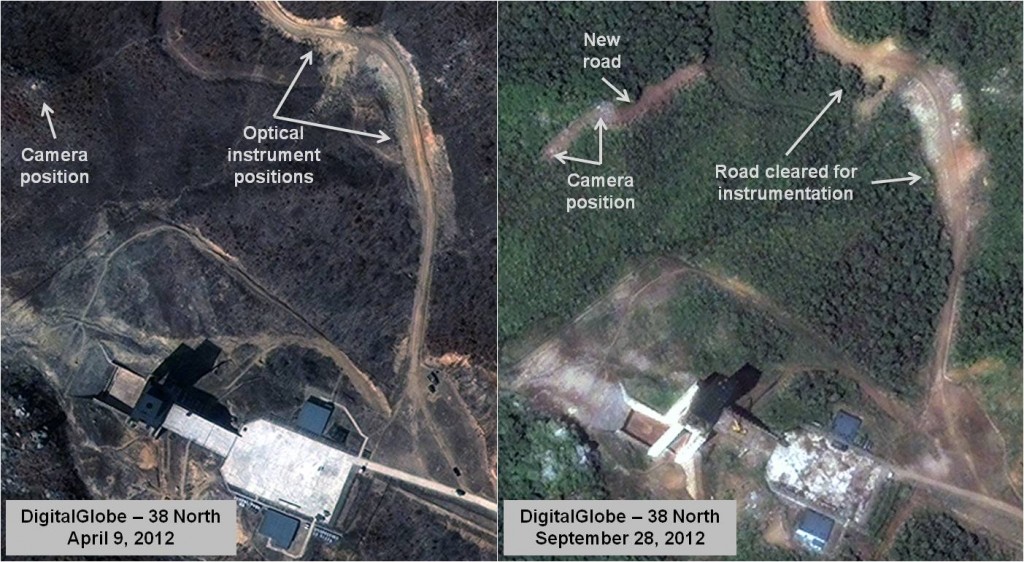
Reinforcing this conclusion, a large truck and trailer parked just off the road headed back to the facility support area appears to be carrying a white, 3.2 meter long, 1.8 meter wide object. While we cannot categorically rule out the possibility that the object may be a large rocket fuel or propellant tank, neither has been seen at Sohae in the past. More likely, the object is a large rocket engine that has recently been tested (see figure 5). Given the width/diameter of the object on the back of the truck, two meters or less, it would appear to more closely conform to that of the KN-08, than the 2.4 meter diameter of the Unha-3 first stage.
Figure 5. Truck and trailer parked just off the road leaving the test stand.
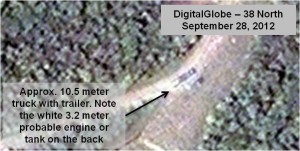
Construction Activity at the Sohae Launch Pad
Satellite imagery also indicates that the North is working on completing the upper gantry platforms needed for future launches of rockets larger than the Unha-3 (see figure 6). Previous satellite imagery showed all four sets of work platforms on the rocket gantry closed and covered with dark canvas. The crane was aligned perpendicular to the long axis of the pad and over the closed work platforms.
Imagery from September 28 shows that, while the lower three sets of platforms remain closed, the top set is retracted back against the gantry. A payload support arm, first photographed by the media on April 8, 2012 is visible. Since a lower arm was used for the Unha-3 vehicle, this arm is intended to support a much taller rocket planned for future launches from Sohae. The gantry crane was aligned over the open platforms, indicating that work was being done.
Figure 6. Construction on the top portion of the Sohae gantry.
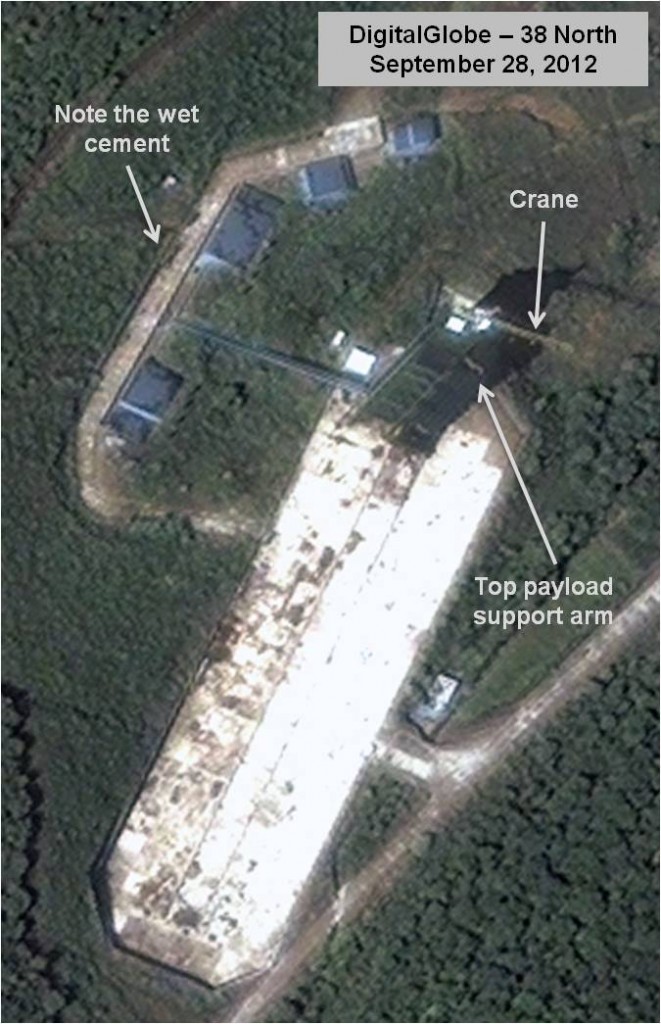
This article was made possible in part by a grant from the Carnegie Corporation of New York. The statements made and views expressed are solely the responsibility of the author(s).
